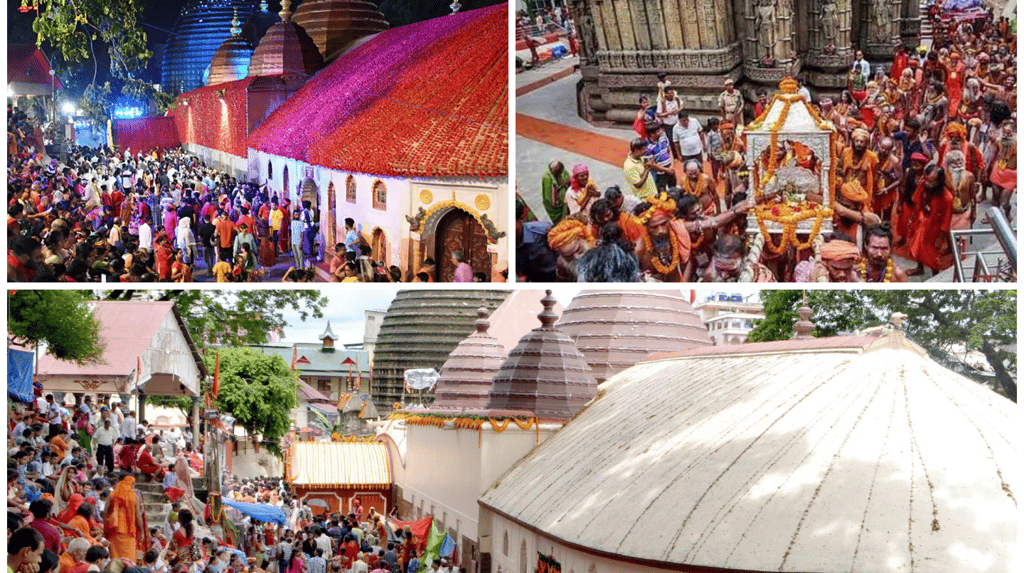The Ambubachi Mela: Celebrating the Sacred Cycle of Mother Earth
Explore the Ambubachi Mela at Kamakhya Temple, Assam a sacred festival honoring the Earth’s fertility cycle and divine feminine power in Indian spirituality.
ASSAM


Resting atop the Nilachal Hill in Guwahati, Assam, stands the revered Kamakhya Temple, a unique and powerful Shakti Peeth. Every year, this ancient shrine becomes the epicenter of a remarkable spiritual gathering: the Ambubachi Mela. Far from being a mere festival, the Ambubachi Mela is a profound celebration of the Earth's fertility, the divine feminine, and the sacredness of menstruation.
What is the Ambubachi Mela?
The Ambubachi Mela is an annual Hindu mela (gathering or fair) held during the monsoon season, typically in the Assamese month of Ahaar, which falls around mid-June. It is popularly known as the "Mahakumbh of the East" due to the immense congregation of devotees, sadhus, and spiritual seekers it attracts from across India and beyond.
The central belief behind the Ambubachi Mela is that Goddess Kamakhya, the presiding deity of the temple and a manifestation of Mother Shakti, undergoes her annual menstrual cycle during this period. This event symbolizes the Earth's fertility and its capacity for creation and regeneration. Unlike many societal taboos surrounding menstruation, the Ambubachi Mela embraces and celebrates it as a vital and sacred aspect of life.
History and Mythology: The Bleeding Goddess
The Kamakhya Temple itself is one of the 51 (or sometimes cited as 108) Shakti Peethas, sacred sites where body parts of Goddess Sati (Lord Shiva's consort) are believed to have fallen after her self-immolation and Lord Shiva's cosmic dance of destruction. It is believed that Sati's yoni (womb and female genital organ) fell at this spot, making Kamakhya the ultimate symbol of fertility, creation, and the life force. The temple is unique as it doesn't house a conventional idol but rather a yoni-shaped stone from which a natural spring flows, symbolizing the goddess's essence.
The Ambubachi Mela, also known as Ameti or the Tantric Fertility Festival, is deeply rooted in the Tantric Shakti cult, which is highly prevalent in Eastern India. Tantric practitioners, including various sects of Sadhus and Aghoris, converge at the temple during this time, some of whom make their public appearances only during these four days, remaining in seclusion for the rest of the year.
Dates and Timings for Ambubachi Mela 2025:
The dates for the Ambubachi Mela vary slightly each year based on the Hindu lunar calendar.
For Ambubachi Mela 2025, the key dates are:
Temple Closes (Pravritti): Evening of June 22, 2025. This marks the symbolic beginning of the goddess's menstruation period.
Temple Closed for Devotees: June 23-24, 2025. During these three days, the temple's main sanctum (Garbhagriha) remains closed to all worshippers, allowing the goddess her sacred seclusion and period of rejuvenation.
Temple Reopens for Darshan (Nivritti): Morning of June 25, 2025. This is a day of immense joy and celebration, as the goddess is believed to have attained her full power and purity.
Festival Concludes: June 26, 2025.
Rituals and Traditions:
The Ambubachi Mela is marked by a series of unique rituals and observances:
Temple Closure: The most prominent ritual is the closure of the Kamakhya Temple's main sanctum for three days. No worship or offerings are performed inside, and daily temple activities are suspended.
Pause in Daily Life: Many devotees and locals observe a pause in certain daily activities during this period, such as farming, cooking, and reading holy books, out of respect for the goddess's sacred rest. This aligns the community spiritually with the divine cycle.
Gathering of Sadhus: The mela attracts a diverse array of sadhus, including Naga Sadhus, Aghoris, and other ascetics, who engage in intense meditation, chanting (Japa), and Tantric practices outside the closed temple doors. Their presence adds a unique mystical atmosphere to the festival.
The Sacred Prasad: On the fourth day, when the temple reopens, devotees eagerly await the unique prasad (blessed offering). This typically includes:
Angodak: Literally meaning "fluid part of the body," this is water from the natural spring within the temple, believed to be sanctified by the goddess's menstrual flow.
Angabastra: Meaning "cloth covering the body," this is a small piece of red cloth that is believed to have been placed over the yoni-shaped stone during the three days of menstruation. It is considered highly auspicious and powerful, especially for women seeking fertility.
Ceremonial Cleansing and Reopening: Before the temple reopens, elaborate cleansing rituals and Vedic chanting are performed by the priests to purify and honor the goddess.
Offerings: Devotees offer items such as red cloth, vermilion, flowers, and fruits to Maa Kamakhya, symbolizing reverence for the natural cycle of womanhood and fertility. While controversial, some traditional animal sacrifices (typically goats or pigeons) are still practiced, though there is a growing trend towards non-violent offerings.
Cultural Extravaganza: Beyond its spiritual aspects, the Ambubachi Mela is a vibrant cultural event. The temple grounds and surrounding areas come alive with spiritual discourses, devotional singing (bhajans), traditional dance performances, and handicraft stalls.
Significance of this Mela:
The Ambubachi Mela holds immense significance:
Celebration of Fertility: It celebrates the natural creative power of the Earth and the divine feminine, challenging societal taboos around menstruation and recognizing it as a source of strength and life.
Tantric Importance: It is one of the most important festivals for Tantric practitioners, offering a rare opportunity to connect with the divine energy of the goddess.
Unity and Faith: The mela brings together millions of people from diverse backgrounds, fostering a sense of unity and shared spiritual devotion.
Cultural Heritage: It showcases the rich cultural heritage of Assam and the unique traditions associated with the Kamakhya Temple.
Visiting the Ambubachi Mela is a truly transformative experience, offering a deep dive into the spiritual heart of India and a unique perspective on the sacredness of life's natural cycles. If you plan to visit, remember to book accommodations well in advance and be prepared for large crowds, especially on the reopening day.
